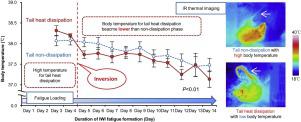当前位置:
X-MOL 学术
›
Neurosci. Res.
›
论文详情
Our official English website, www.x-mol.net, welcomes your
feedback! (Note: you will need to create a separate account there.)
Homeostatic disturbance of thermoregulatory functions in rats with chronic fatigue
Neuroscience Research ( IF 2.4 ) Pub Date : 2020-04-01 , DOI: 10.1016/j.neures.2020.04.005 Danxi Li 1 , Di Hu 2 , Mika Shigeta 2 , Yuta Ochi 2 , Yasuyoshi Watanabe 2 , Feng Li 3 , Yilong Cui 2
Neuroscience Research ( IF 2.4 ) Pub Date : 2020-04-01 , DOI: 10.1016/j.neures.2020.04.005 Danxi Li 1 , Di Hu 2 , Mika Shigeta 2 , Yuta Ochi 2 , Yasuyoshi Watanabe 2 , Feng Li 3 , Yilong Cui 2
Affiliation

|
Chronic fatigue syndrome (CFS) is characterized by long-lasting fatigue, and a range of symptoms, and is involved in homeostasis disruption. CFS patients frequently complain of low grade fever or chill even under normal body temperature indicating that thermosensory or thermoregulatory functions might be disturbed in CFS. However, little is known about the detailed mechanisms. To elucidate whether and how thermoregulatory function was altered during the development of chronic fatigue, we investigated temporal changes in body temperature with advance of fatigue accumulation in a chronic fatigue rat model using a wireless transponder. Our findings demonstrated that the body temperature was adaptively increased in response to fatigue loading in the early phase, but unable to retain in the late phase. The tail heat dissipation was often observed and the frequency of tail heat dissipation gradually increased initially, then decreased. In the late phase of fatigue loading, the body temperature for the tail heat dissipation phase decreased to a value lower than that for the non-dissipation phase. These results suggest that adaptive changes in thermoregulatory function occurred with fatigue progression, but this system might be disrupted by long-lasting fatigue, which may underlie the mechanism of fatigue chronification.
中文翻译:

慢性疲劳大鼠体温调节功能的稳态紊乱
慢性疲劳综合征 (CFS) 的特点是长期疲劳和一系列症状,并与体内平衡破坏有关。即使在正常体温下,CFS 患者也经常抱怨低烧或发冷,这表明 CFS 中的热感觉或体温调节功能可能受到干扰。然而,对详细机制知之甚少。为了阐明在慢性疲劳的发展过程中体温调节功能是否以及如何改变,我们使用无线转发器研究了慢性疲劳大鼠模型中随着疲劳积累的推进体温随时间的变化。我们的研究结果表明,体温在早期响应疲劳负荷而适应性升高,但在后期无法保持。经常观察到尾部散热,尾部散热的频率逐渐增加,然后减少。在疲劳加载后期,尾部散热阶段的体温下降到低于非散热阶段的值。这些结果表明,体温调节功能的适应性变化随着疲劳的进展而发生,但该系统可能会被长期疲劳破坏,这可能是疲劳慢性化机制的基础。
更新日期:2020-04-01
中文翻译:

慢性疲劳大鼠体温调节功能的稳态紊乱
慢性疲劳综合征 (CFS) 的特点是长期疲劳和一系列症状,并与体内平衡破坏有关。即使在正常体温下,CFS 患者也经常抱怨低烧或发冷,这表明 CFS 中的热感觉或体温调节功能可能受到干扰。然而,对详细机制知之甚少。为了阐明在慢性疲劳的发展过程中体温调节功能是否以及如何改变,我们使用无线转发器研究了慢性疲劳大鼠模型中随着疲劳积累的推进体温随时间的变化。我们的研究结果表明,体温在早期响应疲劳负荷而适应性升高,但在后期无法保持。经常观察到尾部散热,尾部散热的频率逐渐增加,然后减少。在疲劳加载后期,尾部散热阶段的体温下降到低于非散热阶段的值。这些结果表明,体温调节功能的适应性变化随着疲劳的进展而发生,但该系统可能会被长期疲劳破坏,这可能是疲劳慢性化机制的基础。









































 京公网安备 11010802027423号
京公网安备 11010802027423号